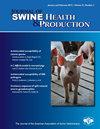接种和未接种胸膜肺炎放线杆菌的猪群血清学监测
IF 0.7
4区 农林科学
Q3 Agricultural and Biological Sciences
引用次数: 0
摘要
目的:探讨自然感染猪和接种猪胸膜肺炎放线杆菌(APP)的血清学诊断。材料与方法:对12个猪场(A-L)进行肺培养和分离血清分型,确定其APP状态。筛选酶联免疫吸附试验(ELISA)检测ApxIV抗原抗体或多种APP血清型。血清型特异性elisa检测血清型5和血清型7。将7组F农场猪(血清型7)转移到K农场(血清型5)。从K农场的APP血清型5培养物制备的自体疫苗(V1/V2)和含有血清型1、7和15的商业化灭活APP疫苗(V3)每3周接种两次或三次,从10周龄开始。采用血清5型、ApxI和ApxII毒素特异性elisa对血样进行分析。采用方差分析比较血清滴度。结果:肺培养中存在血清型5、7、12或15。ApxIV筛选ELISA和混合血清型ELISA定期检测血清型5、7和15。混合血清型ELISA检测到血清12型感染,而ApxIV检测未检测到。血清5型或血清7型特异性ELISA定期检测出相关血清型的群体感染。在等量条件下,接种3次的猪血清5型滴度高于接种2次的猪(P < 0.05)。接种V3的猪没有血清5型抗体反应。接种V1/ v2的猪的ApxI和II滴度高于对照组。意义:筛选和血清型特异性elisa验证APP状态。重复的血清型特异性自体APP疫苗剂量提供了强大的抗体应答。本文章由计算机程序翻译,如有差异,请以英文原文为准。
Serologic monitoring of herds with and without bacterin vaccination for Actinobacillus pleuropneumoniae
Objective: Investigate diagnostic serology for Actinobacillus pleuropneumoniae (APP) infections in naturally infected and vaccinated pigs. Materials and methods: The APP status of 12 farms (A-L) was established by lung cultures and isolate serotyping. Screening enzyme-linked immunosorbent assay (ELISA) detected antibodies to ApxIV antigen or multiple APP serotypes. Serotype-specific ELISAs were conducted for serotypes 5 and 7. Seven groups of farm F pigs (serotype 7) were moved to farm K (serotype 5). Autogenous vaccines (V1/V2) prepared from APP serotype 5 cultures from farm K and a commercial, killed APP vaccine (V3) containing serotypes 1, 7, and 15 were used to vaccinate pigs in each group twice or thrice at 3-week intervals, commencing at 10 weeks of age. Blood samples were analyzed with ELISAs specific for serotype 5 and ApxI and ApxII toxins. Serum titers were compared using an analysis of variance. Results: Serotypes 5, 7, 12, or 15 were present in lung cultures. The ApxIV screening ELISA and mix-serotype ELISA regularly detected serotypes 5, 7, and 15. Serotype 12 infections were detected in the mix-serotype ELISA, but not in the ApxIV assays. The serotype 5 or 7 specific ELISA regularly detected herd infections with the relevant serotype. Serotype 5 titers of pigs vaccinated with V1/V2 thrice were higher than those dosed twice with the equivalent volume (P < .05). Pigs receiving V3 showed no serotype 5 antibody response. The ApxI and II titers in V1/V2-vaccinated pigs were higher than controls. Implications: Screening and serotype-specific ELISAs verified APP status. Repeated serotype-specific autogenous APP vaccine doses provided a strong antibody response.
求助全文
通过发布文献求助,成功后即可免费获取论文全文。
去求助
来源期刊
CiteScore
1.80
自引率
0.00%
发文量
29
审稿时长
>36 weeks
期刊介绍:
The Journal of Swine Health & Production (JSHAP) is an open-access and peer-reviewed journal published by the American Association of Swine Veterinarians (AASV) since 1993. The aim of the journal is the timely publication of peer-reviewed papers with a scope that encompasses the many domains of applied swine health and production, including the diagnosis, treatment, management, prevention and eradication of swine diseases, welfare & behavior, nutrition, public health, epidemiology, food safety, biosecurity, pharmaceuticals, antimicrobial use and resistance, reproduction, growth, systems flow, economics, and facility design. The journal provides a platform for researchers, veterinary practitioners, academics, and students to share their work with an international audience. The journal publishes information that contains an applied and practical focus and presents scientific information that is accessible to the busy veterinary practitioner as well as to the research and academic community. Hence, manuscripts with an applied focus are considered for publication, and the journal publishes original research, brief communications, case reports/series, literature reviews, commentaries, diagnostic notes, production tools, and practice tips. All manuscripts submitted to the Journal of Swine Health & Production are peer-reviewed.

 求助内容:
求助内容: 应助结果提醒方式:
应助结果提醒方式:


